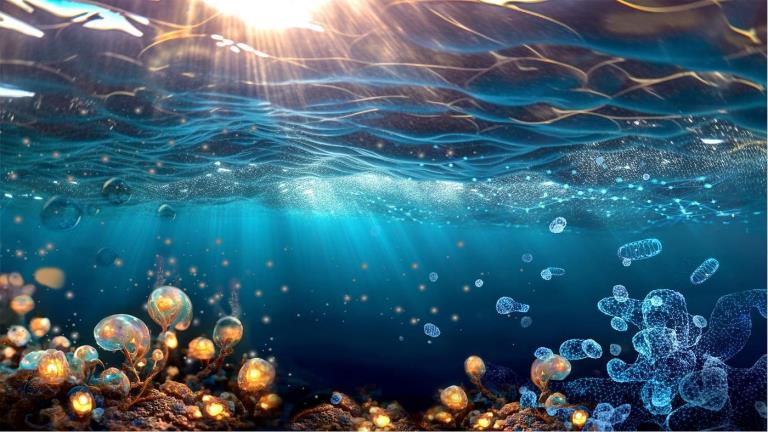Skin energy: from anti-ageing to longevity claims

How do mitochondria produce energy?
Mitochondria are essential organelles referred to as the powerhouses of the cells, named after their unique role in energy production. This process is known as the respiratory chain. Mitochondria use oxygen brought by the air we breathe and glucose or fatty acids from nutrients we ingest to produce adenosine triphosphate (ATP), the cellular energy currency.
With 1 molecule of glucose, a mitochondrion generates up to 38 molecules of ATP:
1 Glucose + 6 O2 → 6 CO2 + 6 H2O + 38 ATP
This aerobic respiratory process is essential to fuel all the cell’s vital functions:
- Metabolism (molecule synthesis and degradation)
- Cellular growth, division and differentiation
- Cell defence and repair

Why are consumers increasingly pursuing energy-boosting products for their skin?
Consumers around the world are experiencing energy exhaustion, exacerbated by geopolitical tensions, persistent inflation and job insecurities amongst many other life challenges. According to Mintel, “physical tiredness and energy loss are major complaints of US women over 55”, while “in the UK, 79% of adults hate feeling low on energy”.
Recent studies demonstrated that energy depletion caused by mitochondrial dysfunctions negatively impacts our health and leads to skin ageing (1) .This presents an opportunity for product claims in skin care, where consumers are increasingly focussed on health and longevity. They seek solutions with proven efficacy to boost their skin energy and immunity. According to Mintel, only 5% of skincare products which make energising claims reference any effect upon ATP, so there is clearly an opportunity for brands to explore this
So, what are the impacts of mitochondrial defects on the skin and how can brands leverage this “skin energy” trend to offer tailored cosmetic solutions?
How do mitochondria impact skin and modulate its ageing?
Beside their role in energy production, mitochondria are also the cell’s key danger response sensors. They can detect stress conditions (Reactive Oxygen Species:, ROS) and modulate cell defence accordingly. They are involved in:
- Cellular response to stress. They can modulate ROS production, release antioxidants and other molecules (AcetylcoA, ATP, NAD+) to ensure cell redox balance and avoid oxidative damage.
- Inflammatory response. They can activate inflammatory and immune pathways to counteract cellular aggression and damage.
- Cell apoptosis. They can release pro-apoptotic factors such as cytochrome C, thereby triggering programmed death of abnormal and damaged cells.
Under normal physiological conditions, ROS serve as redox messengers that regulate intracellular signals. During the ageing process, accumulation of mitochondrial DNA mutations, oxidative phosphorylation malfunction and antioxidant enzyme decline, all increase intracellular ROS production. This imbalance causes irreversible cellular and mitochondrial DNA damage, fuelling a vicious circle of ROS overproduction. As a result, the activity of the respiratory chain declines, altering cellular metabolism and triggering inflammation cascades and further damage to the cells. This is the basis of the free radical ageing theory which explains why mitochondria dysfunctions are a key hallmark of ageing (2) .
Mitochondrial dynamics ensure the organisation of these organelles in a network, which is critical to supporting cell functions and viability. It involves fusion (the mix of two mitochondrial matrix and their components), fission (essential mitochondrial fractionation for cell division) and transport (clear out) of these organelles. Mitochondria occur in filamentous (active) or granular (inactive) forms according to the cell energy needs. Fusion and fission are regenerating processes, similar to the maintenance of car engines, that promote energy production.

fig. 2 - Mitochondrial dynamism
The preservation of the mitochondrial dynamism is critical for its proper functioning. An imbalance increases oxidative stress, reduces fusion promoting isolated inactive forms of mitochondria, and decreases by 5 to 8% the energy production per decade leading to the appearance of ageing-related diseases (3) . However, senescent cells are rich in the fused form of mitochondria, which enables them to resist apoptosis and prolong their survival, leading to tissue ageing. Fission isolates ROS-damaged mitochondria to be eliminated through mitophagy and prevents their cellular accumulation.
Addressing mitochondria dysfunctions to unlock new biological pathways for healthy ageing.
Croda designed different solutions based on specific strategies to counteract mitochondrial dysfunctions and promote energy production.
Addressing mitomembrane potential impairment to combat hypoxiageing™
Mitomembrane potential is crucial to maintain mitochondria homeostasis, energy production and cell functions. Reduction in membrane potential leads to outer membrane permeabilisation and eventually cell apoptosis.
Pollution impairs cell respiration. Particulate matter easily penetrates cell membranes and triggers ROS overproduction. This increase of oxidative stress reduces the mitochondria membrane potential leading to cell defence exhaustion and metabolic damage. This disrupts the epidermal barrier and accelerates skin ageing.
Luceane™ is a unique oligosaccharide extract crafted from marine biotechnology that protects mitochondria against pollution-induced damage. It reduces oxidative stress by preventing antioxidant cell defence exhaustion, maintains the mitochondria membrane potential and boosts cellular respiration and energy production. Luceane stimulates cellular activity and restores the physical and microbial skin barrier for more radiant and regenerated skin.
 Featured
Featured
Luceane™
Tackling mitochondrial dynamic disturbances to restore skin firmness
Dermal fibroblasts are cells naturally under tension due to their attachment to the collagen fibres through adhesion molecules and thanks to their cytoskeleton. The cytoskeleton consists of contractile bundles of actin-myosin fibres that confer contraction properties to the fibroblasts. These properties allow fibroblasts to exert pull on extracellular matrix (ECM) surrounding them and resist mechanical stress. Cytoskeletal contraction is an energy-consuming phenomenon that requires optimum mitochondrial dynamism.
Ultraviolet (UV) exposure increases intracellular ROS production triggering mitochondrial network fragmentation in fibroblasts. The cells lose their contractile capacity and become retracted. As a result, the dermal matrix is no longer tensed and the skin is less firm.
Majestem™ is a callus extract rich in leontopodic acid obtained by cell culture (PCC) of the extremophile plant Leontopodium alpinum, commonly known as Edelweiss. Majestem promotes bioenergetic and biomechanical interrelations. It allows the transformation of the energy produced thanks to the restoration of the mitochondrial dynamics, into mechanical force that reinstates skin contractile properties. Majestem protects extracellular matrix integrity and recreates skin tension for a lifting effect.
 Featured
Featured
Majestem®
 Featured
Featured
PoreTect®
Stimulating mitochondrial water production to protect against IR-ageing
ATP synthesis generates water production in mitochondria. This water diffuses into the cytoplasm and contributes to cell hydration. Infrared radiation (IR) triggers ROS production in cells leading to a decrease of ATP synthesis. The lower ATP synthesis, the lower mitochondrial water production, leading to cellular dehydration.
In addition to the low intracellular hydration, IR exposure accelerates skin drying by thermal evaporation (heat increase) and disrupts the barrier integrity promoting inflammageing.
Venuceane™ is a ferment rich in multifunctional and stable enzymes from a Thermus thermophillus strain. It provides efficient IR protection which involves an adaptive response to increased heat (specific to infrared radiation) and counteracts IR-induced ROS production. Substantiation studies demonstrated that Venuceane™ increases ATP synthesis and mitochondrial water content by 123% promoting skin hydration. It also reduces inflammatory phenomena and smoothes wrinkles.

Venuceane™
To summarise, ATP is essential to life. Mitochondria are the cell organelles responsible for energy production and cell defence signaling. Their dysfunction impedes cellular activity and triggers age-related disorders. Targeting mitochondrial homeostasis offers cosmetic brands a differentiating axis to address various age-related skin claims.
Contact us for further information or to discuss how to harness the other hallmarks of ageing to give rise to a new era of anti-ageing products.
References:
(1) Stout, R., & Birch-Machin, M. (2019). Mitochondria's Role in Skin Ageing. Biology, 8(2), 29.
(2) López-Otín, C., Blasco, M. A., Partridge, L., Serrano, M., & Kroemer, G. (2023). Hallmarks of aging: An expanding universe. Cell, 186(2), 243–278.
(3) Cedikova, M., Pitule, P., Kripnerova, M., Markova, M., & Kuncova, J. (2016). Multiple roles of mitochondria in aging processes. Physiological research, 65(Suppl 5), S519–S531.